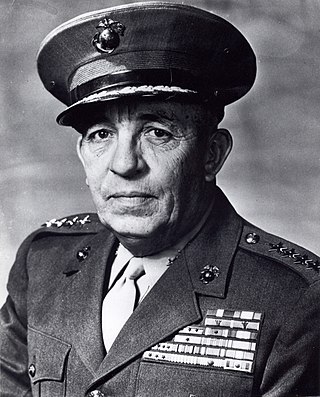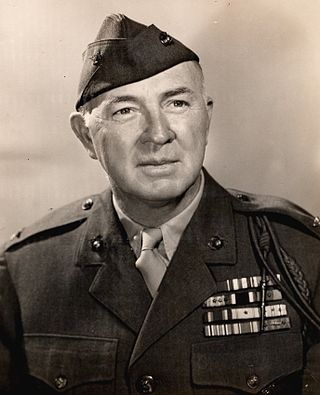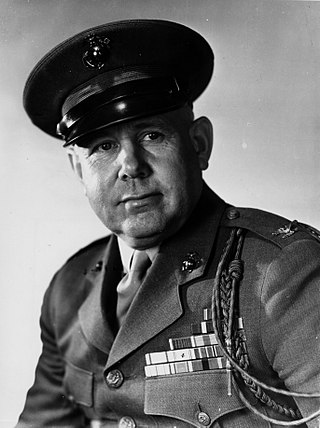
Edwin Allen Pollock was a United States Marine Corps General and a highly decorated combat veteran of World War II and Korea; he commanded both the 1st and 2d Marine Divisions and is the only man to have served as commanding general of both the Atlantic and Pacific Fleet Marine Force. He had been advanced to the rank of general upon retirement by reason of having been specially commended in combat.

Merwin Hancock Silverthorn was a highly decorated Lieutenant General in the United States Marine Corps, Navy Cross recipient.

Victor France Bleasdale was a brigadier general in the United States Marine Corps. He was awarded the Navy Cross and Distinguished Service Cross for his actions during the Battle of Blanc Mont Ridge in World War I. Later he received a second Navy Cross for his service at the Battle of San Fernando during the Second Nicaraguan Campaign.

Leo David "Dutch" Hermle was a highly decorated officer in the United States Marine Corps with the rank of lieutenant general. He was a recipient of Army and Navy second highest decorations, Navy Cross and Distinguished Service Cross, which he earned during his service in both World Wars.

Samuel Calvin Cumming was a highly decorated officer of the United States Marine Corps with the rank of major general. He is most noted for his service as assistant division commander of the 4th Marine Division during Mariana Islands Campaign and previously as commanding officer of 25th Marine Regiment during Battle of Kwajalein. He was a nephew of Hugh S. Cumming, former Surgeon General of the United States.

Littleton Waller Tazewell Waller, Jr. was a highly decorated officer of the United States Marine Corps who attained the rank of major general while serving as Marine Corps Director of Personnel during World War II.

Louis Reeder Jones was a highly decorated major general in the United States Marine Corps during World War II. He was a recipient of Navy Cross for his service with 23rd Marine Regiment during Saipan and Tinian Campaigns.

Oscar Ray Cauldwell was an officer of the United States Marine Corps with the rank of major general, who served as assistant division commander of 3rd Marine Division and later as commanding general of the Training Command, Fleet Marine Force, San Diego, during World War II.

Arnold Windom Jacobsen was an officer of the United States Marine Corps with the rank of major general, who served as commanding officer of the Marine Corps Supplies Depots during World War II and was responsible for the equipment and supplies of the Marine Corps units overseas.

Harold Denny Campbell was a United States Marine Corps major general who served in World War I and World War II. He is most noted for his service as an aviation officer who commanded the 2nd Marine Aircraft Wing in the Pacific theater and on the staff of Lord Mountbatten during World War II.

Gilder Davis Jackson Jr. was a highly decorated officer of the United States Marine Corps with the rank of brigadier general, who is most noted for his service as commanding officer of the 6th Marine Regiment during the Guadalcanal Campaign.

Harold Ellett Rosecrans was a highly decorated officer of the United States Marine Corps with the rank of brigadier general, who commanded 2nd Battalion 5th Marines during the during the assault on Tulagi Island. He later commanded 17th Marine Regiment during Battle of Cape Gloucester.

Richard Hall Jeschke was a decorated officer of the United States Marine Corps with the rank of brigadier general, who commanded 8th Marine Regiment during the Battle of Guadalcanal. He later served in the European Theater and participated in the planning of the Invasion of Normandy and the Invasion of Sicily.

John Thaddeus Walker was a highly decorated officer of the United States Marine Corps, who reached the rank of lieutenant general. He is most noted as commanding officer of the 22nd Marine Regiment during Battle of Eniwetok. He later served as director of personnel or commanding general of Marine Corps Recruit Depot San Diego.

Robert Houston Pepper was an officer of the United States Marine Corps with the rank of lieutenant general, who is most noted for his work in the development of the Marine defense battalions during World War II and later as commanding general of the Fleet Marine Force, Pacific or 3rd Marine Division.

Henry William Buse Jr. was a lieutenant general in the United States Marine Corps. He was Chief of Staff, Headquarters Marine Corps and later commanding general of the Fleet Marine Force Pacific. Following his retirement from the Marine Corps, Buse served as assistant to three former presidents of the U.S. Olympic Committee.

Charles Ira Murray was a highly decorated officer of the United States Marine Corps with the rank of brigadier general, who distinguished himself while serving with 6th Marine Regiment during World War I.

Lester Adolphus Dessez was a decorated officer of the United States Marine Corps with the rank of brigadier general. He is most noted as commanding officer of 7th Defense Battalion during World War II.

Henry Dallas Linscott was a decorated officer of the United States Marine Corps with the rank of lieutenant general. He is most noted for his service on the staff of Amphibious Force Commander, Admiral Richmond K. Turner during World War II and later as the commanding general of the Department of the Pacific and Camp Lejeune.

James Frederick Moriarty was a highly decorated officer in the United States Marine Corps with the rank of brigadier general. A veteran of World War I, he distinguished himself several times as a company officer with the 6th Machine Gun Battalion and received four awards of the Silver Star.




















